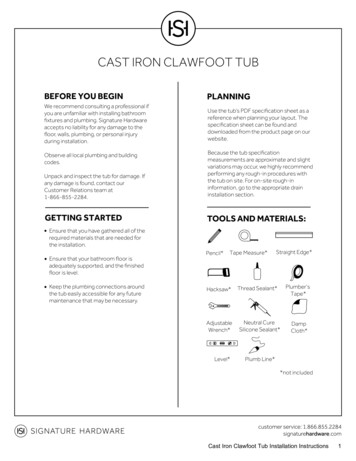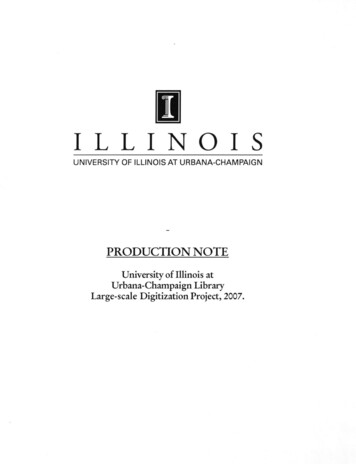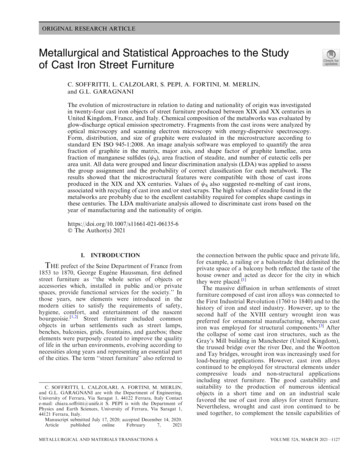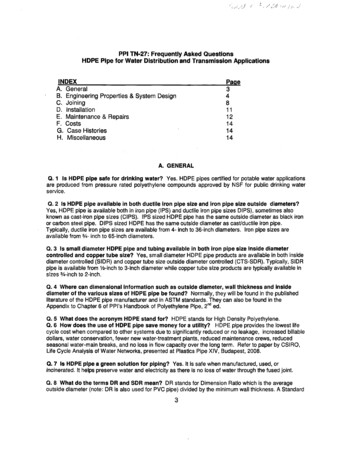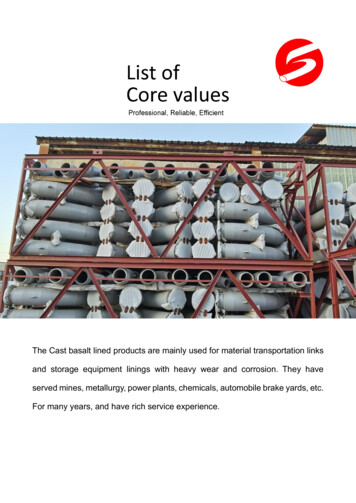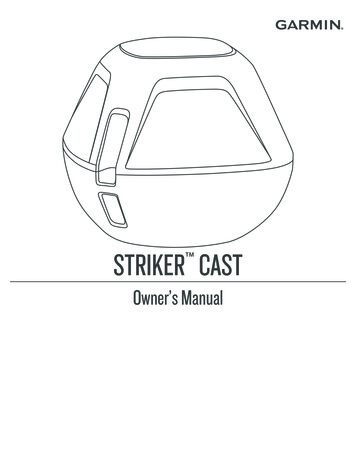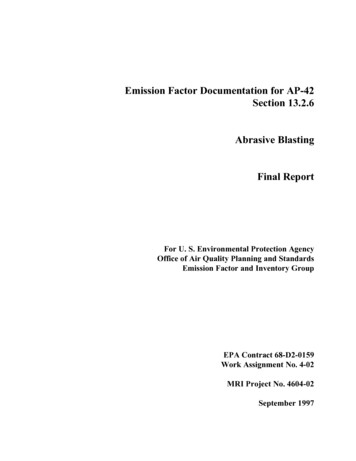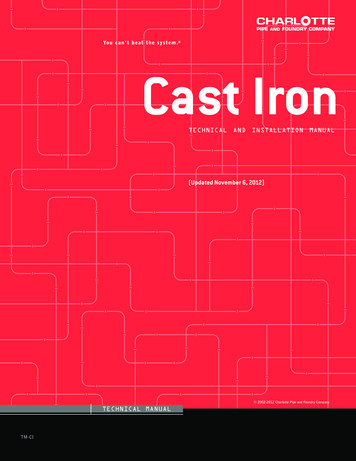
Transcription
Cast IronTECHNICAL AND INSTALLATION MANUAL(Updated November 6, 2012) 2002-2012 Charlotte Pipe and Foundry CompanyTECHNICAL MANUALTM-CI
INTRODUCTIONCast Iron InstallationAs the leading manufacturer of cast iron soil pipe and fittings, Charlotte Pipe and Foundry can be yourone-stop source for all your cast iron piping system needs. We manufacture a full line of Service andExtra Heavy cast iron soil pipe and fittings from 2” - 15”, and Double-Hub pipe from 2” - 6”. We alsomanufacture a full line of No-Hub (hubless) pipe and fittings, 11/2” - 15”. All of our products are proudlymade in the U.S.A. and meet or exceed all applicable ASTM and CISPI standards.Charlotte Pipe has been relentless in our commitment to quality and service for more than a century.Through the years we have broadened and enhanced our product lines to meet customer demand. We’vefocused on continuous process improvement to serve you better. All told, we’ve invested millions to improvemanufacturing efficiency, productivity and capacity, making our foundry one of the most modern of itstype in the world.Charlotte Pipe and Foundry Company, Cast Iron DivisionWe appreciate your business and we look forward to serving your need for information and premiumquality cast iron plumbing systems. You may also find the safety and technical information contained inthis manual on our web site, www.charlottepipe.com.Charlotte Pipe and “You can’t beat the system” are registered trademarks of Charlotte Pipe and Foundry Company.2
TABLE OF CONTENTSGENERAL INFORMATIONPageIntroduction . 2Understanding Safety Alert Messages . 5Components of the DWV System . 6Performance . 6-8Resistance to Abrasion. 7The Green Choice. 7Soundproofing Qualities of Cast Iron Systems. 7-8Product Availability. 8Receiving, Handling and Storage of Cast Iron Pipe and Fittings . 8-9Receiving Cast Iron Shipments. 8Storage of Pipe and Fittings. 8Physical Properties of Gray Iron. 9Product Specification . 10-12Service Cast Iron Soil Pipe and Fittings. 10Extra Heavy Cast Iron Soil Pipe and Fittings. 11No-Hub (Hubless) Cast Iron Soil Pipe and Fittings. 12Product Certification . 13Product Data . 14-20Service Cast Iron. 14-15Extra Heavy Cast Iron. 16-17Dimensional Tolerances for Extra Heavy and Service Cast IronSoil Pipe & Fittings. 18Hubless Cast Iron. 19-20DESIGN AND ENGINEERING DATAGravity Flow . 21Manning Roughness Factor (“N” Value). 21“N” Values for Typical Piping Materials. 21Self-cleansing Velocities. 21Design of Sewer and Drains. 21Fluid Flow Properties . 22-27Velocity Charts. 22-27Support Spacing and Hangers . 28Fire Resistance of Cast Iron Systems . 28Reference Standards . 293
TABLE OF CONTENTSCast Iron InstallationINSTALLATION PROCEDURES FOR CAST IRONCutting Methods for Cast Iron Soil Pipe . 30Cutting Cast Iron Soil Pipe with a Snap Cutter. 30Joining Methods for Cast Iron Soil Pipe . 31-34Compression Gaskets. 31Making a Compression-gasket Joint. 32-33Installing Fittings with Compression-gasket Joints. 33-34Important Reminders and Helpful Hints about Compression-gasket Joints. 34Hubless Joints . 35-40Making Hubless Joints. 36-37Underground Installation Procedures . 37-38Under-slab Installation . 38Above-ground Installation Procedures . 38-39Installing Vertical Piping. 38-39Installing Horizontal Piping - Suspended. 39Installing Horizontal Fittings. 39TESTING AND INSPECTIONWater or Hydrostatic Testing. 40Thrust Forces. 41The Smoke Test. 42The Peppermint Test. 42SPECIAL CONSIDERATIONSHow to Determine Right- or Left-hand Inlets . 43Painting Cast Iron Soil Pipe . 43Siphonic Roof Drains . 43LIMITED WARRANTY . 444
GENERAL INFORMATIONUnderstanding Safety Alert MessagesIt is important to read and understand this manual. It contains information to help protect your safety and preventproblems.This is the safety alert symbol. It is used to alertyou to potential personal injury hazards. Obey allsafety messages that follow this symbol to avoidpersonal injury or death.“WARNING” Indicates a hazardous situation which, if notavoided, could result in severe injury or death.“CAUTION” Indicates a hazardous situation which, if notavoided, could result in minor or moderate injury.“NOTICE” Indicates a hazardous situation which, if notavoided, may result in system failure and property damage.READ & SAVE THESE INSTRUCTIONS5
GENERAL INFORMATIONCOMPONENTS OF THE DWV SYSTEMEngineers and designers have a number of materials fromwhich to choose as they design sanitary and storm drainagesystems for residential and commercial projects. Due toits exceptional strength and combination of being noncombustible and extremely quiet, cast iron soil pipe is avery popular choice for commercial construction. Upscalehomes often feature cast iron stacks combined with plasticused for lavs, showers and tubs for a system Charlotte Pipecalls a “Quiet House ” design.Cast iron soil pipe is primarily used in the construction ofbuildings. It serves well in sanitary-drain, storm-drain,waste-line, and vent-line applications. The product iswidely used in commercial, industrial, and residentialconstruction. Common examples include hospitals, schools,stadiums, prisons, and private dwellings. Cast iron soil pipeis the primary DWV material used in high-rise buildingconstruction.Inside homes and buildings, sanitary piping is installedwithin partitions and is connected to tubs, lavatories,water closets and other fixtures. The main component ofthe DWV system is called the cast iron soil stack. This isthe vertical piping line that runs upward from the buildingdrain, continues up through the structure, and penetratesthe plane of the roof. Waste lines convey waste from thefixtures to the main stack. Vent lines are the system’ssource of outside air, which allows the system to functionproperly by preventing a vacuum from forming. Ventlines are tied into the system at a point above the highestfixture. In some installations vent lines are connected toa separate vent stack.A lower section of horizontal piping within the structure’sDWV system is called the drain. It receives dischargefrom the upper portion of the system and carries it to thebuilding’s sewer. The building sewer routes discharge to thepoint outside the structure prescribed by the local plumbingcode, where it connects to the city sewer, or a septic tank.Within the area of building construction, cast iron soil pipeand fittings are widely used for storm drainage from roofs,yards, areaways, and courts. Cast iron piping is used forcollecting runoff from sub-soil drains, which are positionedaround the foundation. These drains relieve the foundationfrom groundwater by channeling it into a storm drainagesystem, or a sump pump.Soil pipe also serves well as roof leaders and storm drains.6Cast Iron InstallationThe design specifications for high-rise structures with largesetbacks often call for soil pipe to carry large amountsof rain water and snow melt. Outside the area of buildingconstruction and storm drainage, cast iron piping is usedin condensate lines, bridge drainage, and swimming pooldrainage lines.Failure to follow instructions or safety precautions mayresult in serious or fatal injury and/or property damage.PERFORMANCECast Iron is a generic term that identifies a large familyof ferrous alloys. Cast irons are primarily alloys of ironthat contain more than 2% carbon and 1% or more ofsilicon. Cast iron can be cast into intricate shapes becauseof its excellent fluidity. Because of the excellent propertiesobtainable with these low-cost engineering materials, castiron finds wide application in environments that demandgood corrosion resistance including water, storm andsanitary drain, waste and vent applications.Quality gray iron castings, like the ones produced byCharlotte Pipe and Foundry, have an abundance of freegraphite present in their microstructure. When Charlotteproducts are exposed to most corrosive agents, an insolublelayer of corrosion protection is left behind, which helpsprovide a durable barrier against additional corrosion.Unique corrosion-resistance characteristics make itideally suited for plumbing applications. The metallurgicalcomposition of our cast iron products, specifically thepresence of free graphite, ensures that if there is corrosion,it will occur only on the exposed surface and to extremelyshallow depths. The graphite layer prevents additionalcorrosion.NOTICE: A small percentage of very special wastes maynot be suitable for cast iron plumbing systems. Suchwaste streams can emanate from laboratories, someconcentrated or undiluted carbonated soft drink sources,and sites where specific types of cleaning chemicals aredischarged, particularly when the effluent is undiluted.The very low pH wastes from such sources can corrodeexposed cast iron.
GENERAL INFORMATIONThe pH range for typical DWV systems is between 4.5 and7. We suggest that the installer establish a uniform slopefor horizontal drainage piping, but not less than permittedby applicable plumbing code and in compliance with goodplumbing practices, to facilitate flushing of the system.If operating conditions yield an acidity level of pH 4.3 orless, we recommend dilution of the waste stream to raisethe pH. If this is not possible, we suggest that the system’sdesigner look into a more suitable material.concentration of decomposing organic matter (swamps,peat bogs, etc.), alkalis or salt (tidal) marshes.The National Bureau of Standards and the Cast Iron PipeResearch Association (now known as the Ductile IronPipe Research Association) have studied the undergroundcorrosion of cast iron pipe for many years. As a resultof these studies, a procedure has been developed fordetermining the need for any special corrosion protection.This procedure uses a point system to evaluate five soilcharacteristics. The procedure and an optional polyethlenefilm protection system are provided as an appendix toASTM A 74. Additional information is available fromCISPI or Charlotte Pipe.The Green ChoiceThe corrosion of metals underground is an electrochemicalphenomenon of two main types: galvanic and electrolytic.Galvanic corrosion is self-generating and occurs on thesurface of a metal exposed to an electrolyte (such as moist,salt-laden soil). The action is similar to that occurring in awet- or dry-cell battery. Differences in electrical potentialbetween areas on the surface of the metal (pipe) in contactwith such soil may occur for a variety of reasons, includingthe joining of different metals (iron and copper or brass).Potential differences may also be due to the characteristicsof the soil in contact with the pipe surface: e.g. pH, solublesalt, oxygen and moisture content, temperature and thepresence of certain bacteria. Any one of a combinationof these factors may cause a small amount of electricalcurrent to flow through the soil between areas on the pipeor metal surface. Where this current discharges into thesoil from such an area, metal is removed from the pipesurface and corrosion occurs.Electrolytic corrosion occurs when direct current fromoutside sources enters and the leaves an undergroundmetal structure such as pipe. At that point where currentleaves the metal surface to return to its source throughthe soil, metal is removed and corrosion occurs.Over 95 percent of the soil in the United States is noncorrosive to cast iron. Those few soils that are somewhatcorrosive to cast iron include natural soils containing highResistance to AbrasionCast iron pipe and fittings are highly resistant to abrasionfrom sand, gravel, garbage disposal residue, dishwasherdischarge, and debris being carried in suspension alongthe lower portion of the sewer or drain.A trend toward environmentally sustainable buildingpractices has grown in recent years. The U.S. governmentrequires that federal government projects use greenbuilding practices. Many state and local agencies alsooffer incentives to encourage the construction of greenbuildings.Charlotte Pipe and Foundry certifies that its cast ironpipe and fitting products are made from a minimum of95% recycled content (0% post-industrial material) andare 100% recyclable. Each year we prevent more than350 million pounds of scrap iron and steel from enteringovercrowded landfills by converting it into cast iron soilpipe and fittings. At the end of the life of a building, thecast iron piping can be recovered and recycled again tomake new cast iron pipe and fittings or other metallicproducts.While plumbing products themselves cannot earn pointstoward LEED certification on a project, they do meetthe growing demand by project owners and specifiers toemploy more “green” products.The choice is clear when your project calls for recycled orreusable plumbing material; Charlotte Pipe and Foundry.Testing with or use of compressed air or gas in Cast Ironpipe or fittings can result in explosive failures and causesevere injury or death. NEVER test with or transport/storecompressed air or gas in Cast Iron pipeor fittings. NEVER test Cast Iron pipe or fittingswith compressed air or gas. ONLY use Cast Iron pipe and fittingsfor drain, waste and vent or sanitarysewer applications.7
GENERAL INFORMATIONSoundproofing Qualities of Cast IronSystemsOne of the most significant features of cast iron pipe,compression gaskets and hubless couplings is their sounddeadening quality. The problem of noise is particularlyacute in multi-family housing. Although soundproofinghas become a major concern in construction design,certain plumbing products have been introduced that notonly transmit noise, but may actually amplify it. The useof neoprene gaskets and hubless couplings with cast ironpipe and fittings significantly reduces noise and vibration.As a result of the composition and structure of cast iron,sound is muffled rather than transmitted or amplified, andthe neoprene separates the length of pipe and the unit offittings to help suppress contact-related sound. The resultis that objectionable plumbing noises are minimized oreliminated.Product AvailabilityOur cast iron foundry is located in Charlotte, NorthCarolina where all of our products are proudly made in theUSA. We have an ample supply of pipe and fittings in stockat all times. Contractors need not be concerned aboutsupply or shortages since the manufacturing capacity isadequate and readily obtainable from Charlotte Pipe.To reduce the risk of serious injury, follow the forkliftmanufacturer’s safety precautions. Read and follow allapplicable codes and regulations, including 29 C.F.R.1910.178.Cast Iron Installationand stresses normally encountered in transit. The firststep upon arrival of the material at the destinationshould be a thorough inspection for any damage that mayhave occurred in transit. The shipment will usually beaccompanied with a “bill of lading” and a packing slip.The purpose of the bill of lading is the legal transfer oftitle for the material from the manufacturer to the carrierand from the carrier to the installer or wholesaler who isreceiving the shipment. It is essential that any damageor shortage of products be immediately noted on the billof lading and filed with the carrier involved or CharlottePipe within ten (10) days after receipt of product. Thebill of lading will reflect total pieces, bundles, or crates.The packing list will give a specific description of eachitem shipped. It is necessary that the total pieces bechecked and any discrepancies noted on the bill of ladingbefore the carrier leaves the delivery destination. NotifyCharlotte Pipe of the discrepancies as noted on the billof lading as soon as possible. Failure to note damageor shortages may result in claims not being honored. Acopy of this document should be kept in a safe place ifdamage or shortages were noted. Charlotte Pipe ships itspipe pre-packaged in bundles and its fittings in boxes foreasy unloading. Care should be taken when unloading theunit. Shipping tags are attached to each bundle and boxidentifying the contents of each unit. These tags should notbe removed as they will be useful later in locating itemsas they are needed.Storage of Pipe and FittingsCast iron pipe and fittings can be stored outside and donot require any special covering to protect them fromthe elements. Pre-packaged bundles of cast iron pipe can weighhundreds or thousands of pounds; exercise cautionwhen unloading a flatbed truck or moving bundles ofpipe around in your yard. Pre-packaged fittings come in wooden crates and canalso weigh several hundreds of pounds; exercise cautionwhen unloading or moving these crates around.RECEIVING, HANDLING AND STORAGEOF CAST IRON PIPE AND FITTINGSReceiving Cast Iron ShipmentsCast iron pipe and fittings are customarily shipped byflatbed truckloads. Cast iron will withstand the shock8To reduce the risk of serious injury, follow the forkliftmanufacturer’s safety precautions. Read and follow allapplicable codes and regulations, including 29 C.F.R.1910.178. Pre-packaged bundles of cast iron pipe can weighhundreds or thousands of pounds; exercise cautionwhen unloading a flatbed truck or moving bundles ofpipe around in your yard. Pre-packaged fittings come in wooden crates and canalso weigh several hundreds of pounds; exercise cautionwhen unloading or moving these crates around.
GENERAL INFORMATIONGray Iron Physical PropertiesComposition of Gray IronTensile Strength20,000 p.s.i. — 60,000 p.s.i.(21,000 p.s.i.)The following are typical ranges of elements presentin unalloyed gray cast iron normally produced incommercial practice:Elastic Modulus(Young’s modulus)10 - 23 x 106 p.s.i.Hardness (Brinell)Thermal ConductivityCarbon (C)2.60 - 3.85%Silicon (Si)1.25 - 2.90%Manganese (Mn)0.40 - 1.00%Phosphorus (P)0.02 - 0.90%Sulfur (S)0.04 - 0.20%150 - 250 BHN0.110 - 0.137calories/cm2/Sec/cm/ CThermal Expansion10 x 10-6 / C6 x 10-6 / FDensity0.25 - 0.28 lb./in6.95 - 7.35 gm/cm3Specific Heat0.13 BTU / lb / F0.13 cal / gm / C39
GENERAL INFORMATIONCast Iron InstallationPRODUCT SPECIFICATIONSystem:Service Cast Iron Soil Pipe and FittingsScope:This specification covers Service Cast Iron pipe, fittings, and compression gaskets used in sanitarydrain, waste, and vent (DWV), sewer, and storm drainage applications. This system is intendedfor use in non-pressure applications.Specification:Service Cast Iron pipe and fittings shall be manufactured from gray cast iron with a tensile strengthof not less than 21,000 psi. Compression gaskets shall be manufactured from an elastomer meetingthe requirements of ASTM C 564.Pipe and fittings shall comply with ASTM A 74. Compression gaskets shall comply with ASTMC 564. All pipe and fittings shall be made in the United States and marked with the collectivetrademark of the Cast Iron Soil Pipe Institute, , and listed by NSF International. All pipeand fittings shall be of the same manufacturer. All systems shall utilize a separate waste and ventsystem.Installation shall comply with the latest installation instructions published by Charlotte Pipe andFoundry and shall conform to all applicable plumbing, fire, and building code requirements. Jointsshall be made with an elastomeric compression gasket meeting the requirements of ASTM C 564,or lead and oakum. The system shall be hydrostatically tested after installation to 10 ft. of head(4.3 psi maximum). WARNING! Never test with or transport/store compressed air or gas in CastIron pipe or fittings; doing so can result in explosive failures and cause severe injury or death.Referenced Standards:ASTM A 74ASTM C 564Cast Iron Soil Pipe and FittingsRubber Gaskets for Cast Iron Soil Pipe and FittingsNote: Latest revision of each standard applies.Short Specification:Hub and Spigot Cast Iron Soil Pipe and Fittings:Hub and Spigot Cast Iron pipe and fittings shall be manufactured from gray cast iron and shallconform to ASTM A 74. All pipe and fittings shall be marked with the collective trademark of theCast Iron Soil Pipe Institute , and listed by NSF International. Pipe and fittings to be Service(SV). Joints can be made using a compression gasket manufactured from an elastomer meetingthe requirements of ASTM C 564, or lead and oakum. All pipe and fittings are to be produced bya single manufacturer and are to be installed in accordance with manufacturer’s recommendationsand applicable code requirements. The system shall be hydrostatically tested after installation to10 ft. of head (4.3 psi maximum). WARNING! Never test with or transport/store compressedair or gas in Cast Iron pipe or fittings; doing so can result in explosive failures and cause severeinjury or death.P0 Box 3543010Charlotte, NC 28235 USA704/348-6450800/572-4199FAX 800/553-1605www.charlottepipe.com
GENERAL INFORMATIONPRODUCT SPECIFICATIONSystem:Extra Heavy Cast Iron Soil Pipe and FittingsScope:This specification covers Extra Heavy Cast Iron pipe, fittings, and compression gaskets used insanitary drain, waste, and vent (DWV), sewer, and storm drainage applications. This system isintended for use in non-pressure applications.Specification:Extra Heavy Cast Iron pipe and fittings shall be manufactured from gray cast iron with a tensilestrength of not less than 21,000 psi. Compression gaskets shall be manufactured from an elastomermeeting the requirements of ASTM C 564.Pipe and fittings shall comply with ASTM A 74. Compression gaskets shall comply with ASTMC 564. All pipe and fittings shall be made in the United States and marked with the collectivetrademark of the Cast Iron Soil Pipe Institute, , and listed by NSF International. All pipeand fittings shall be of the same manufacturer. All systems shall utilize a separate waste and ventsystem.Installation shall comply with the latest installation instructions published by Charlotte Pipe andFoundry and shall conform to all applicable plumbing, fire, and building code requirements. Jointsshall be made with an elastomeric compression gaskets meeting the requirements of ASTM C 564,or lead and oakum. The system shall be hydrostatically tested after installation to 10 ft. of head(4.3 psi maximum). WARNING! Never test with or transport/store compressed air or gas in CastIron pipe or fittings; doing so can result in explosive failures and cause severe injury or death.Referenced Standards:ASTM A 74ASTM C 564Cast Iron Soil Pipe and FittingsRubber Gaskets for Cast Iron Soil Pipe and FittingsNote: Latest revision of each standard applies.Short Specification:Hub and Spigot Cast Iron Soil Pipe and Fittings:Hub and Spigot Cast Iron pipe and fittings shall be manufactured from gray cast iron and shallconform to ASTM A 74. All pipe and fittings shall be marked with the collective trademark of the Cast Iron Soil Pipe Instituteand listed by NSF International. Pipe and fittings to be ExtraHeavy (XH). Joints can be made using a compression gasket manufactured from an elastomermeeting the requirements of ASTM C 564, or lead and oakum. All pipe and fittings are to beproduced by a single manufacturer and are to be installed in accordance with manufacturer’srecommendations and applicable code requirements. The system shall be hydrostatically testedafter installation to 10 ft. of head (4.3 psi maximum). WARNING! Never test with or transport/store compressed air or gas in Cast Iron pipe or fittings; doing so can result in explosive failuresand cause severe injury or death.P0 Box 35430Charlotte, NC 28235 USA704/348-6450800/572-4199FAX 800/553-1605www.charlottepipe.com11
GENERAL INFORMATIONCast Iron InstallationPRODUCT SPECIFICATIONSystem:Hubless Cast Iron Soil Pipe and FittingsScope:This specification covers hubless Cast Iron pipe, fittings, and couplings used in sanitary drain,waste, and vent (DWV), sewer, and storm drainage applications. This system is intended for usein non-pressure applications.Specification:Hubless Cast Iron pipe and fittings shall be manufactured from gray cast iron with a tensilestrength of not less than 21,000 psi. Regular hubless couplings shall be shielded and conform toCISPI Standard 310 with an elastomeric gasket meeting the requirements of ASTM C 564 andbe certified by NSF International. Heavy Duty hubless couplings shall be shielded and conformto ASTM C 1540, with an elastomeric gasket meeting the requirements of ASTM C 564.Pipe and fittings shall comply with CISPI 301. All pipe and fittings shall be made in the UnitedStates and marked with the collective trademark of the Cast Iron Soil Pipe Institute, , andlisted by NSF International. All pipe and fittings shall be of the same manufacturer. All systemsshall utilize a separate waste and vent system.Installation shall comply with the latest installation instructions published by Charlotte Pipe andFoundry and shall conform to all applicable plumbing, fire, and building code requirements. Jointsshall be made with hubless couplings and tightened using a calibrated torque wrench. The systemshall be hydrostatically tested after installation to 10 ft. of head (4.3 psi maximum). WARNING!Never test with or transport/store compressed air or gas in Cast Iron pipe or fittings; doing so canresult in explosive failures and cause severe injury or death.Referenced Standards:ASTM C 564Rubber Gaskets for Cast Iron Soil Pipe and FittingsCISPI 301Hubless Cast Iron Soil Pipe and FittingsCISPI 310Hubless Couplings for Cast Iron Soil Pipe and FittingsASTM C 1277Hubless CouplingsASTM C 1540Hubless Heavy Duty CouplingsNote: Latest revision of each standard applies.Short Specification:Hubless Cast Iron Soil Pipe and Fittings:Hubless Cast Iron pipe and fittings shall be manufactured from gray cast iron and shall conformto CISPI Standard 301. All pipe and fittings shall be marked with the collective trademark ofthe Cast Iron Soil Pipe Institute and listed by NSF International. Hubless Couplings shallconform to CISPI Standard 310 and be certified by NSF International. Heavy Duty Couplingsshall conform to ASTM C 1540 and shall be used if indicated. Gaskets shall conform to A
Cast Iron Installation As the leading manufacturer of cast iron soil pipe and fittings, Charlotte Pipe and Foundry can be your one-stop source for all your cast iron piping system needs. We manufacture a full line of Service and Extra Heavy cast iron soil pipe and fittings from 2" - 15", and Double-Hub pipe from 2" - 6". We also
